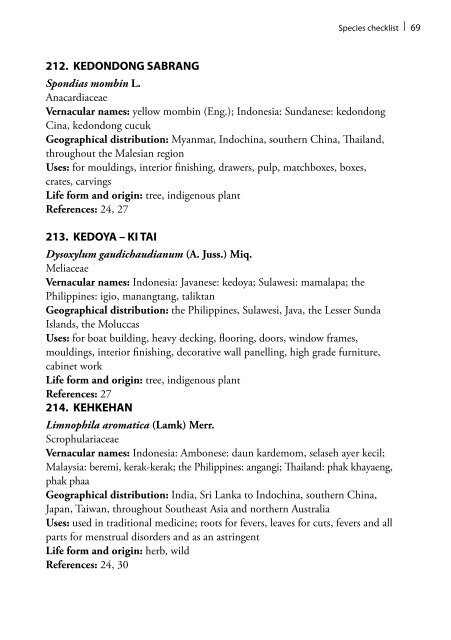Five hundred plant species in gunung Halimun Salak ... - CIFOR
Five hundred plant species in gunung Halimun Salak ... - CIFOR
Five hundred plant species in gunung Halimun Salak ... - CIFOR
You also want an ePaper? Increase the reach of your titles
YUMPU automatically turns print PDFs into web optimized ePapers that Google loves.
212. KEDONDONG SABRANG<br />
Species checklist | 69<br />
Spondias momb<strong>in</strong> L.<br />
Anacardiaceae<br />
Vernacular names: yellow momb<strong>in</strong> (Eng.); Indonesia: Sundanese: kedondong<br />
C<strong>in</strong>a, kedondong cucuk<br />
Geographical distribution: Myanmar, Indoch<strong>in</strong>a, southern Ch<strong>in</strong>a, Thailand,<br />
throughout the Malesian region<br />
Uses: for mould<strong>in</strong>gs, <strong>in</strong>terior f<strong>in</strong>ish<strong>in</strong>g, drawers, pulp, matchboxes, boxes,<br />
crates, carv<strong>in</strong>gs<br />
Life form and orig<strong>in</strong>: tree, <strong>in</strong>digenous <strong>plant</strong><br />
References: 24, 27<br />
213. KEDOYA – KI TAI<br />
Dysoxylum gaudichaudianum (A. Juss.) Miq.<br />
Meliaceae<br />
Vernacular names: Indonesia: Javanese: kedoya; Sulawesi: mamalapa; the<br />
Philipp<strong>in</strong>es: igio, manangtang, taliktan<br />
Geographical distribution: the Philipp<strong>in</strong>es, Sulawesi, Java, the Lesser Sunda<br />
Islands, the Moluccas<br />
Uses: for boat build<strong>in</strong>g, heavy deck<strong>in</strong>g, floor<strong>in</strong>g, doors, w<strong>in</strong>dow frames,<br />
mould<strong>in</strong>gs, <strong>in</strong>terior f<strong>in</strong>ish<strong>in</strong>g, decorative wall panell<strong>in</strong>g, high grade furniture,<br />
cab<strong>in</strong>et work<br />
Life form and orig<strong>in</strong>: tree, <strong>in</strong>digenous <strong>plant</strong><br />
References: 27<br />
214. KEHKEHAN<br />
Limnophila aromatica (Lamk) Merr.<br />
Scrophulariaceae<br />
Vernacular names: Indonesia: Ambonese: daun kardemom, selaseh ayer kecil;<br />
Malaysia: beremi, kerak-kerak; the Philipp<strong>in</strong>es: angangi; Thailand: phak khayaeng,<br />
phak phaa<br />
Geographical distribution: India, Sri Lanka to Indoch<strong>in</strong>a, southern Ch<strong>in</strong>a,<br />
Japan, Taiwan, throughout Southeast Asia and northern Australia<br />
Uses: used <strong>in</strong> traditional medic<strong>in</strong>e; roots for fevers, leaves for cuts, fevers and all<br />
parts for menstrual disorders and as an astr<strong>in</strong>gent<br />
Life form and orig<strong>in</strong>: herb, wild<br />
References: 24, 30

















